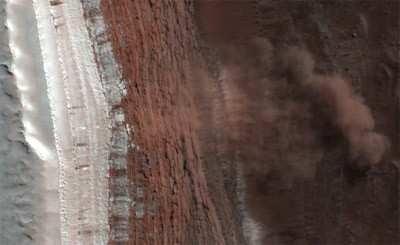Images Show Brownish "Snow" Cascading Near North Pole
A NASA spacecraft in orbit around Mars has taken the first ever
image of active avalanches near the Red Planet's north pole. The
image shows tan clouds billowing away from the foot of a towering
slope, where ice and dust have just cascaded down.

The High Resolution Imaging Experiment (HiRISE) on NASA's Mars
Reconnaissance Orbiter took the photograph February 19. It is one
of approximately 2,400 HiRISE images being released this week.
Ingrid Daubar Spitale of the University of Arizona, Tucson, who
works on targeting the camera and has studied hundreds of HiRISE
images, was the first person to notice the avalanches. "It really
surprised me," she said. "It's great to see something so dynamic on
Mars. A lot of what we see there hasn't changed for millions of
years."
The camera is looking repeatedly at selected places on Mars to
track seasonal changes. However, the main target of the February 19
image was not the steep slope.
"We were checking for springtime changes in the carbon-dioxide
frost covering a dune field, and finding the avalanches was
completely serendipitous," said Candice Hansen, deputy principal
investigator for HiRISE, at NASA's Jet Propulsion Laboratory in
Pasadena, CA.

The full image reveals features as small as a desk in a strip of
terrain 6 kilometers (3.7 miles) wide and more than 10 times that
long, at 84 degrees north latitude. Reddish layers known to be rich
in water ice make up the face of a steep slope more than 700 meters
(2,300 feet) tall, running the length of the image.
"We don't know what set off these landslides," said Patrick
Russell of the University of Berne, Switzerland, a HiRISE team
collaborator. "We plan to take more images of the site through the
changing Martian seasons to see if this kind of avalanche happens
all year or is restricted to early spring."
More ice than dust probably makes up the material that fell from
the upper portion of the scarp. Imaging of the site during coming
months will track any changes in the new deposit at the base of the
slope. That will help researchers estimate what proportion is
ice.
"If blocks of ice broke loose and fell, we expect the water in
them will be changing from solid to gas," Russell said. "We'll be
watching to see if blocks and other debris shrink in size. What we
learn could give us a better understanding of one part of the water
cycle on Mars."

Another notable HiRISE image shows a blue crescent Earth and its
moon, as seen by the Mars Reconnaissance Orbiter. The west coast of
South America is visible in the photo. Still other images allow
viewers to explore a wide variety of Martian terrains, such as
dramatic canyons and rhythmic patterns of sand dunes.
The camera is one of six science instruments on the orbiter. The
spacecraft reached Mars in March 2006 and has returned more data
than all other current and past missions to Mars combined.
"Our Mars program is the envy of the world," said Alan Stern,
associate administrator of NASA's Science Mission Directorate,
Washington. "We plan to launch a total of five more missions in the
next decade, beginning with the Mars Science Lab rover next year
and a Mars Aeronomy Scout mission in 2011."
 NTSB Final Report: Rutan Long-EZ
NTSB Final Report: Rutan Long-EZ ANN FAQ: Turn On Post Notifications
ANN FAQ: Turn On Post Notifications Classic Aero-TV: ICAS Perspectives - Advice for New Air Show Performers
Classic Aero-TV: ICAS Perspectives - Advice for New Air Show Performers ANN's Daily Aero-Linx (06.28.25)
ANN's Daily Aero-Linx (06.28.25) Aero-News: Quote of the Day (06.28.25)
Aero-News: Quote of the Day (06.28.25)





